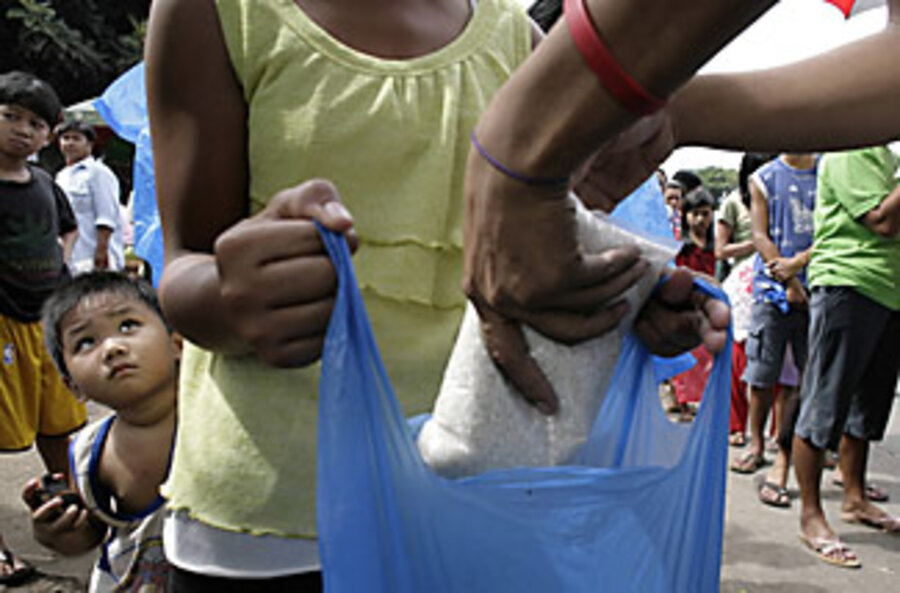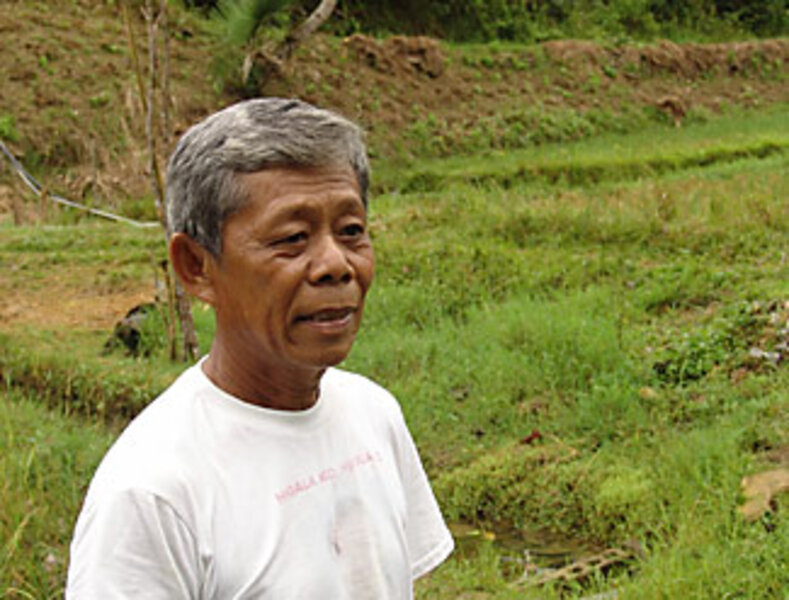Roots of Asia's rice crisis
Loading...
| BOHOL, Philippines
Gantallan Plorensio's farm is a paradox at the heart of Asia's growing rice crisis. The fields that get enough water have never been more productive, contributing to a 5 percent annual increase in rice production over the past two years.
"We have a lot of rice fields, but no irrigation," he says. "They're just sitting there."
As a regional rice crisis looms, threatening political instability and social unrest, the idle fields in Mr. Plorensio's village underscore a failure of policy and foresight repeated across the region: For decades, governments have been encouraging a boom in services and skyscrapers, but not the capacity to grow more rice. Financing in agriculture has stagnated, and fewer farmers are expected to produce more rice for exploding populations.
That neglect is one of the central causes of what some analysts call the "perfect storm" – including rising global oil prices, drought in Australia, and inclement weather – behind the rice crisis.
"It's a failure to recognize the importance of agriculture," says Duncan Macintosh, a spokesman for the International Rice Research Institute, based in Laguna, about 40 miles from Manila, the capital of the Philippines. "Agriculture is becoming a very unfashionable industry."
Philippines at the center of crisis
At the epicenter of the storm is the Philippines, the world's largest importer of rice. The island nation annually imports between 10 to 15 percent of its rice. But because global rice supplies are so tight – causing India, China, Cambodia, and Vietnam to restrict exports – the Philippines is having a hard time fulfilling an import order of around one million tons.
The country is paying exorbitant prices for whatever rice it can get its hands on, driving up prices around the world to double last year's.
A shortfall of 10 percent is expected for 2008, causing fears that food riots could erupt here as they have in countries such as Haiti, Egypt, Mexico, Burkina Faso, and Senegal.
Those are just concerns so far in the Philippines, but the government of President Gloria Macapagal-Arroyo – like the governments of Haiti and Malaysia, among others – has been shaken by the growing crisis and faced with public calls for her ouster.
At the center of the storm lies a simple question: Why can't the Philippines, and other countries in Asia, produce enough rice to feed themselves?
Some reasons are beyond the direct control of the Philippines and other Asian archipelagos like Indonesia and Malaysia. Because their farmland is spread over thousands of miles and different islands, production, maintenance, and transportation make rice cultivation expensive and difficult.
"Thailand, the world's largest [rice] producer, has 9.82 million [hectares of rice fields]. The Philippines has 4 million hectares of productive farmland. And those 4 million hectares are spread over 7,000 miles," says Mr. Macintosh, adding that the Philippines also lacks a river delta, which by providing an easy and abundant water source, allows Asian countries like Vietnam, India, and Cambodia to produce higher rice harvests.
Other factors in the rice crisis are also beyond the Philippines' control. Rising oil prices have made rice more expensive to produce, by increasing fertilizer and transportation costs; pests in Vietnam, one of the world's largest producers, have wiped out as much as 200,000 tons; and the collapse of Australia's rice production due to drought has eaten away at global rice stocks.
But many other factors are directly a failure of foresight here, as in the rest of Asia. Although government spending on agriculture accelerated in the 1960s and '70s, pumped into irrigation systems, fertilizer, and rice breeding that spawned the Green Revolution, it slowed by half throughout the 1990s, according to one study. In 2002, the Philippines invested only $0.46 for every $100 of agricultural output, a level consistent with the rest of Asia, according to a study by International Food Policy Research Institute (IFPRI) in Washington. It means that Asia is a slacker when it comes to investment in agriculture compared with the rest of the developing world, which spent $.053 for every $100 of agricultural output, and the developed world, which spent more than $2.0. The global average was around $.070.
Instead, Asia is increasingly transforming farmland into office parks and suburbs. In the Philippines, half of irrigated land has been transformed into urban development in the past two decades. While this fuels new economic engines such as services and industry, it also undercuts resources needed to grow food.
Less water, land, labor for farming
"Manufacturing is demanding more and more water. Asia expects to grow 1 percent more rice every year – but they're supposed to do that on less water, less land, and less labor," says Macintosh.
Perhaps most important of all, there are simply more mouths to feed.
The population in the Philippines has grown by roughly 2 percent a year since 2000, one of the highest rates in Asia, leading to a corresponding leap in rice consumption. And across Asia, exploding middle classes with more money and bigger appetites are eating more rice – and more meat. Meat production requires huge amounts of water, labor, and grains to feed cattle, which in turn diverts resources away from rice production.
And yet, despite this obvious population growth, governments throughout Asia have assumed they could always import more and more food, according to analysts. Global stocks of rice, as with other grains, are at their lowest since 1976, depleted by a combination of population growth, less farmland, poor planning, and bad weather.
"There's been no incentive for rice self-sufficiency in the Philippines. It was always so easy to buy rice from your neighbor," says Angelito Banyo, director of PR Politik, a think tank in Manila.
The current crisis has exposed the fallacy of thinking that supplies are in abundance, analysts say. It has also underscored a need for better coordination in Asia's rice trade, they add.
Instead of coordinating policies to respond to a problem that is affecting all of Asia, India, China, and Cambodia, among others, have imposed strict export restrictions, leaving countries like Malaysia and the Philippines to scramble for any deals they can grab. That will only cause prices of rice to climb higher in the open market, analysts say.
Filipino officials said last week that the country is spearheading a regional meeting of 10 Asian countries to discuss the crisis, tentatively scheduled for this summer. Some analysts, however, don't expect much to come out of it.
"Rice is such a politically sensitive issue. Countries are not going modify their rice prices to satisfy others. They're going to pursue prices that they believe are in their national interest," says Nicholas Minot, a senior research fellow at IFPRI.
Reactions inside Asian countries have not helped, either. Hoarding has become a problem in India and Bangladesh, and caused such domestic price spirals in the Philippines that the government has threatened life imprisonment to prevent it.
Solutions, analysts warn, will not be immediate, but could take the form of food-for-work programs, targeted school feeding programs, and conditional cash transfers (where poor households are given cash assistance if they attend health clinics and keep their children in school).
"These types of programs are more effective in helping people adjust to the high prices than price controls or universal food subsidies," says Mr. Minot.
In the Philippines, Arroyo's short-term response has been to flood markets with highly subsidized rice, broker a quick deal with Vietnam for 2.2 million tons of rice, and call for a halt on converting farmland into development space. Observers say they're all steps in the right direction. "The Philippines is a relatively positive situation, where the government is taking very productive steps," says Paul Risley, a spokesman for the World Food Program in Thailand.
Investment needed and on the way
But as the crisis mounts, observers agree that Asia needs a second Green Revolution, a movement launched in the 1960s that resulted in double rice yields through better irrigation and investments in rice technology. Money has to be put back into the science of feeding, they say.
"In the long term, developing countries and the international community need to increase investment in agricultural research and development to develop new disease resistant, higher-yielding varieties," Minot adds.
The Philippines looks to be doing just that: Last week, President Arroyo announced a $1 billion investment to improve rice production. The money would go toward seed production and training and loans to farmers, as well as updating irrigation and transport systems. "We must work harder to grow and breed what we need," President Arroyo said recently at a national food summit.
Small farms like Plorensio's in Bohol, meanwhile, show that investments can pay off. Four years ago, the local government introduced a plant-now pay-later scheme, allowing farmers to buy seeds from a bank, rather than planting their own. Production is way up over the past few years, Plorensio says.
A few weeks ago, Plorensio and other farmers in his town petitioned their local congressman for a $12,000 loan to fund an irrigation system. If the loan comes through, he says, those rice fields won't be idle any longer.






